Zihan Qiu
additional authors not shown
Blending Supervised and Reinforcement Fine-Tuning with Prefix Sampling
Jul 02, 2025Abstract:Existing post-training techniques for large language models are broadly categorized into Supervised Fine-Tuning (SFT) and Reinforcement Fine-Tuning (RFT). Each paradigm presents a distinct trade-off: SFT excels at mimicking demonstration data but can lead to problematic generalization as a form of behavior cloning. Conversely, RFT can significantly enhance a model's performance but is prone to learn unexpected behaviors, and its performance is highly sensitive to the initial policy. In this paper, we propose a unified view of these methods and introduce Prefix-RFT, a hybrid approach that synergizes learning from both demonstration and exploration. Using mathematical reasoning problems as a testbed, we empirically demonstrate that Prefix-RFT is both simple and effective. It not only surpasses the performance of standalone SFT and RFT but also outperforms parallel mixed-policy RFT methods. A key advantage is its seamless integration into existing open-source frameworks, requiring only minimal modifications to the standard RFT pipeline. Our analysis highlights the complementary nature of SFT and RFT, and validates that Prefix-RFT effectively harmonizes these two learning paradigms. Furthermore, ablation studies confirm the method's robustness to variations in the quality and quantity of demonstration data. We hope this work offers a new perspective on LLM post-training, suggesting that a unified paradigm that judiciously integrates demonstration and exploration could be a promising direction for future research.
Qwen3 Technical Report
May 14, 2025Abstract:In this work, we present Qwen3, the latest version of the Qwen model family. Qwen3 comprises a series of large language models (LLMs) designed to advance performance, efficiency, and multilingual capabilities. The Qwen3 series includes models of both dense and Mixture-of-Expert (MoE) architectures, with parameter scales ranging from 0.6 to 235 billion. A key innovation in Qwen3 is the integration of thinking mode (for complex, multi-step reasoning) and non-thinking mode (for rapid, context-driven responses) into a unified framework. This eliminates the need to switch between different models--such as chat-optimized models (e.g., GPT-4o) and dedicated reasoning models (e.g., QwQ-32B)--and enables dynamic mode switching based on user queries or chat templates. Meanwhile, Qwen3 introduces a thinking budget mechanism, allowing users to allocate computational resources adaptively during inference, thereby balancing latency and performance based on task complexity. Moreover, by leveraging the knowledge from the flagship models, we significantly reduce the computational resources required to build smaller-scale models, while ensuring their highly competitive performance. Empirical evaluations demonstrate that Qwen3 achieves state-of-the-art results across diverse benchmarks, including tasks in code generation, mathematical reasoning, agent tasks, etc., competitive against larger MoE models and proprietary models. Compared to its predecessor Qwen2.5, Qwen3 expands multilingual support from 29 to 119 languages and dialects, enhancing global accessibility through improved cross-lingual understanding and generation capabilities. To facilitate reproducibility and community-driven research and development, all Qwen3 models are publicly accessible under Apache 2.0.
Gated Attention for Large Language Models: Non-linearity, Sparsity, and Attention-Sink-Free
May 10, 2025Abstract:Gating mechanisms have been widely utilized, from early models like LSTMs and Highway Networks to recent state space models, linear attention, and also softmax attention. Yet, existing literature rarely examines the specific effects of gating. In this work, we conduct comprehensive experiments to systematically investigate gating-augmented softmax attention variants. Specifically, we perform a comprehensive comparison over 30 variants of 15B Mixture-of-Experts (MoE) models and 1.7B dense models trained on a 3.5 trillion token dataset. Our central finding is that a simple modification-applying a head-specific sigmoid gate after the Scaled Dot-Product Attention (SDPA)-consistently improves performance. This modification also enhances training stability, tolerates larger learning rates, and improves scaling properties. By comparing various gating positions and computational variants, we attribute this effectiveness to two key factors: (1) introducing non-linearity upon the low-rank mapping in the softmax attention, and (2) applying query-dependent sparse gating scores to modulate the SDPA output. Notably, we find this sparse gating mechanism mitigates 'attention sink' and enhances long-context extrapolation performance, and we also release related $\href{https://github.com/qiuzh20/gated_attention}{codes}$ and $\href{https://huggingface.co/QwQZh/gated_attention}{models}$ to facilitate future research.
Demons in the Detail: On Implementing Load Balancing Loss for Training Specialized Mixture-of-Expert Models
Jan 21, 2025Abstract:This paper revisits the implementation of $\textbf{L}$oad-$\textbf{b}$alancing $\textbf{L}$oss (LBL) when training Mixture-of-Experts (MoEs) models. Specifically, LBL for MoEs is defined as $N_E \sum_{i=1}^{N_E} f_i p_i$, where $N_E$ is the total number of experts, $f_i$ represents the frequency of expert $i$ being selected, and $p_i$ denotes the average gating score of the expert $i$. Existing MoE training frameworks usually employ the parallel training strategy so that $f_i$ and the LBL are calculated within a $\textbf{micro-batch}$ and then averaged across parallel groups. In essence, a micro-batch for training billion-scale LLMs normally contains very few sequences. So, the micro-batch LBL is almost at the sequence level, and the router is pushed to distribute the token evenly within each sequence. Under this strict constraint, even tokens from a domain-specific sequence ($\textit{e.g.}$, code) are uniformly routed to all experts, thereby inhibiting expert specialization. In this work, we propose calculating LBL using a $\textbf{global-batch}$ to loose this constraint. Because a global-batch contains much more diverse sequences than a micro-batch, which will encourage load balance at the corpus level. Specifically, we introduce an extra communication step to synchronize $f_i$ across micro-batches and then use it to calculate the LBL. Through experiments on training MoEs-based LLMs (up to $\textbf{42.8B}$ total parameters and $\textbf{400B}$ tokens), we surprisingly find that the global-batch LBL strategy yields excellent performance gains in both pre-training perplexity and downstream tasks. Our analysis reveals that the global-batch LBL also greatly improves the domain specialization of MoE experts.
Qwen2.5 Technical Report
Dec 19, 2024Abstract:In this report, we introduce Qwen2.5, a comprehensive series of large language models (LLMs) designed to meet diverse needs. Compared to previous iterations, Qwen 2.5 has been significantly improved during both the pre-training and post-training stages. In terms of pre-training, we have scaled the high-quality pre-training datasets from the previous 7 trillion tokens to 18 trillion tokens. This provides a strong foundation for common sense, expert knowledge, and reasoning capabilities. In terms of post-training, we implement intricate supervised finetuning with over 1 million samples, as well as multistage reinforcement learning. Post-training techniques enhance human preference, and notably improve long text generation, structural data analysis, and instruction following. To handle diverse and varied use cases effectively, we present Qwen2.5 LLM series in rich sizes. Open-weight offerings include base and instruction-tuned models, with quantized versions available. In addition, for hosted solutions, the proprietary models currently include two mixture-of-experts (MoE) variants: Qwen2.5-Turbo and Qwen2.5-Plus, both available from Alibaba Cloud Model Studio. Qwen2.5 has demonstrated top-tier performance on a wide range of benchmarks evaluating language understanding, reasoning, mathematics, coding, human preference alignment, etc. Specifically, the open-weight flagship Qwen2.5-72B-Instruct outperforms a number of open and proprietary models and demonstrates competitive performance to the state-of-the-art open-weight model, Llama-3-405B-Instruct, which is around 5 times larger. Qwen2.5-Turbo and Qwen2.5-Plus offer superior cost-effectiveness while performing competitively against GPT-4o-mini and GPT-4o respectively. Additionally, as the foundation, Qwen2.5 models have been instrumental in training specialized models such as Qwen2.5-Math, Qwen2.5-Coder, QwQ, and multimodal models.
Video Repurposing from User Generated Content: A Large-scale Dataset and Benchmark
Dec 12, 2024Abstract:The demand for producing short-form videos for sharing on social media platforms has experienced significant growth in recent times. Despite notable advancements in the fields of video summarization and highlight detection, which can create partially usable short films from raw videos, these approaches are often domain-specific and require an in-depth understanding of real-world video content. To tackle this predicament, we propose Repurpose-10K, an extensive dataset comprising over 10,000 videos with more than 120,000 annotated clips aimed at resolving the video long-to-short task. Recognizing the inherent constraints posed by untrained human annotators, which can result in inaccurate annotations for repurposed videos, we propose a two-stage solution to obtain annotations from real-world user-generated content. Furthermore, we offer a baseline model to address this challenging task by integrating audio, visual, and caption aspects through a cross-modal fusion and alignment framework. We aspire for our work to ignite groundbreaking research in the lesser-explored realms of video repurposing. The code and data will be available at https://github.com/yongliang-wu/Repurpose.
Post-hoc Reward Calibration: A Case Study on Length Bias
Sep 25, 2024



Abstract:Reinforcement Learning from Human Feedback aligns the outputs of Large Language Models with human values and preferences. Central to this process is the reward model (RM), which translates human feedback into training signals for optimising LLM behaviour. However, RMs can develop biases by exploiting spurious correlations in their training data, such as favouring outputs based on length or style rather than true quality. These biases can lead to incorrect output rankings, sub-optimal model evaluations, and the amplification of undesirable behaviours in LLMs alignment. This paper addresses the challenge of correcting such biases without additional data and training, introducing the concept of Post-hoc Reward Calibration. We first propose an intuitive approach to estimate the bias term and, thus, remove it to approximate the underlying true reward. We then extend the approach to a more general and robust form with the Locally Weighted Regression. Focusing on the prevalent length bias, we validate our proposed approaches across three experimental settings, demonstrating consistent improvements: (1) a 3.11 average performance gain across 33 reward models on the RewardBench dataset; (2) enhanced alignment of RM rankings with GPT-4 evaluations and human preferences based on the AlpacaEval benchmark; and (3) improved Length-Controlled win rate of the RLHF process in multiple LLM--RM combinations. Our method is computationally efficient and generalisable to other types of bias and RMs, offering a scalable and robust solution for mitigating biases in LLM alignment. Our code and results are available at https://github.com/ZeroYuHuang/Reward-Calibration.
Layerwise Recurrent Router for Mixture-of-Experts
Aug 13, 2024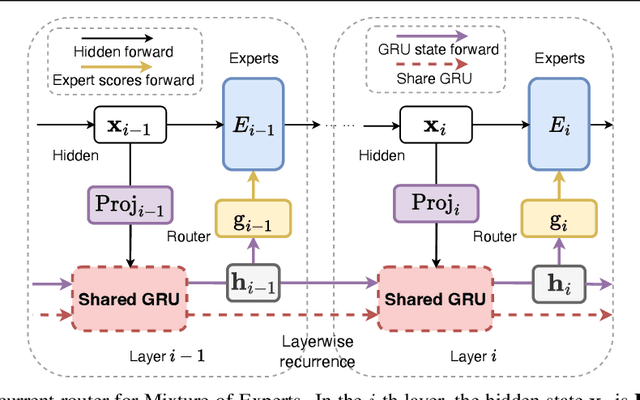
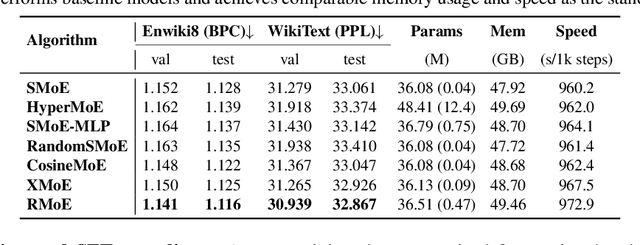
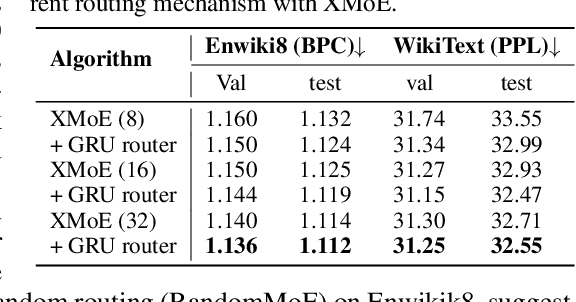
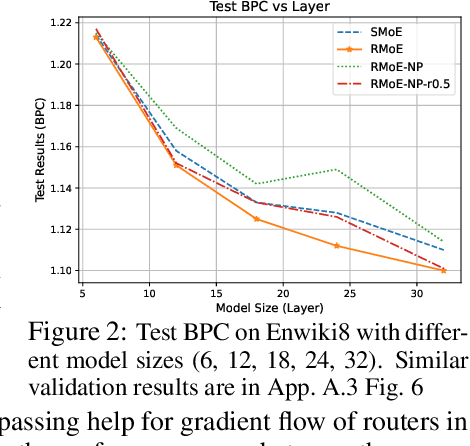
Abstract:The scaling of large language models (LLMs) has revolutionized their capabilities in various tasks, yet this growth must be matched with efficient computational strategies. The Mixture-of-Experts (MoE) architecture stands out for its ability to scale model size without significantly increasing training costs. Despite their advantages, current MoE models often display parameter inefficiency. For instance, a pre-trained MoE-based LLM with 52 billion parameters might perform comparably to a standard model with 6.7 billion parameters. Being a crucial part of MoE, current routers in different layers independently assign tokens without leveraging historical routing information, potentially leading to suboptimal token-expert combinations and the parameter inefficiency problem. To alleviate this issue, we introduce the Layerwise Recurrent Router for Mixture-of-Experts (RMoE). RMoE leverages a Gated Recurrent Unit (GRU) to establish dependencies between routing decisions across consecutive layers. Such layerwise recurrence can be efficiently parallelly computed for input tokens and introduces negotiable costs. Our extensive empirical evaluations demonstrate that RMoE-based language models consistently outperform a spectrum of baseline models. Furthermore, RMoE integrates a novel computation stage orthogonal to existing methods, allowing seamless compatibility with other MoE architectures. Our analyses attribute RMoE's gains to its effective cross-layer information sharing, which also improves expert selection and diversity. Our code is at https://github.com/qiuzh20/RMoE
Reconstructing Global Daily CO2 Emissions via Machine Learning
Jul 29, 2024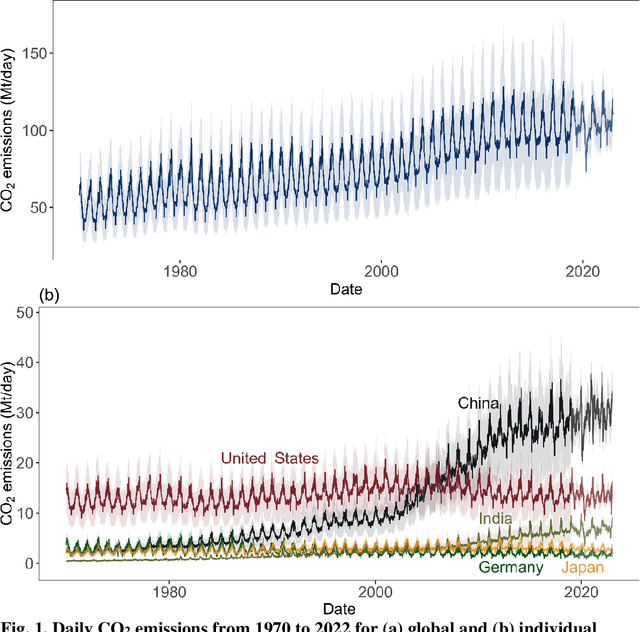

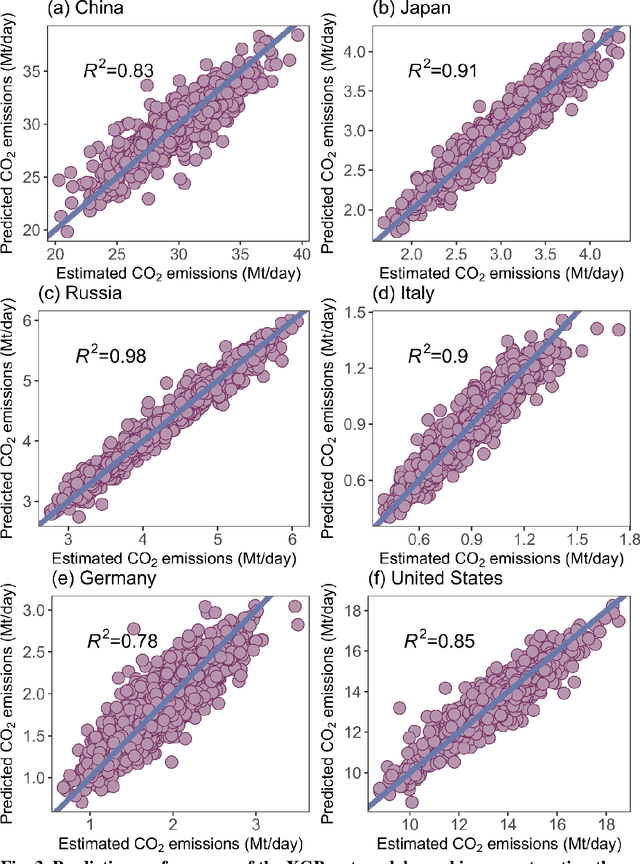
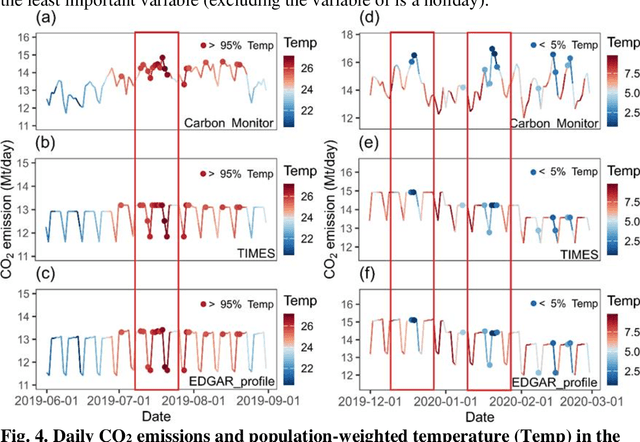
Abstract:High temporal resolution CO2 emission data are crucial for understanding the drivers of emission changes, however, current emission dataset is only available on a yearly basis. Here, we extended a global daily CO2 emissions dataset backwards in time to 1970 using machine learning algorithm, which was trained to predict historical daily emissions on national scales based on relationships between daily emission variations and predictors established for the period since 2019. Variation in daily CO2 emissions far exceeded the smoothed seasonal variations. For example, the range of daily CO2 emissions equivalent to 31% of the year average daily emissions in China and 46% of that in India in 2022, respectively. We identified the critical emission-climate temperature (Tc) is 16.5 degree celsius for global average (18.7 degree celsius for China, 14.9 degree celsius for U.S., and 18.4 degree celsius for Japan), in which negative correlation observed between daily CO2 emission and ambient temperature below Tc and a positive correlation above it, demonstrating increased emissions associated with higher ambient temperature. The long-term time series spanning over fifty years of global daily CO2 emissions reveals an increasing trend in emissions due to extreme temperature events, driven by the rising frequency of these occurrences. This work suggests that, due to climate change, greater efforts may be needed to reduce CO2 emissions.
A Closer Look into Mixture-of-Experts in Large Language Models
Jun 26, 2024
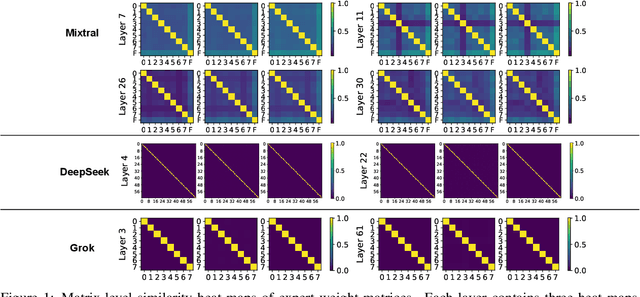
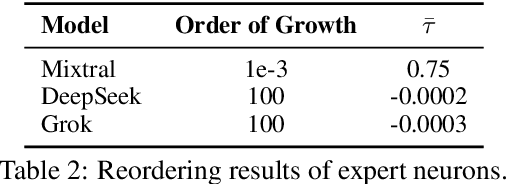
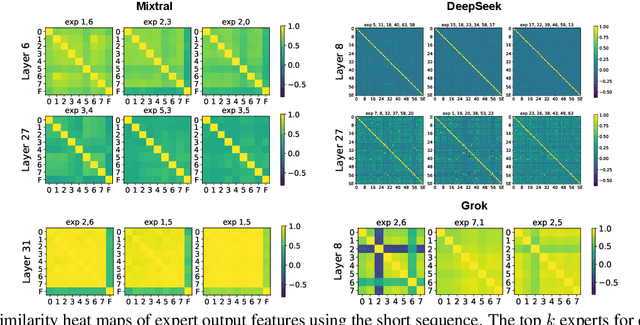
Abstract:Mixture-of-experts (MoE) is gaining increasing attention due to its unique properties and remarkable performance, especially for language tasks. By sparsely activating a subset of parameters for each token, MoE architecture could increase the model size without sacrificing computational efficiency, achieving a better trade-off between performance and training costs. However, the underlying mechanism of MoE still lacks further exploration, and its modularization degree remains questionable. In this paper, we make an initial attempt to understand the inner workings of MoE-based large language models. Concretely, we comprehensively study the parametric and behavioral features of three recent MoE-based models and reveal some intriguing observations, including (1) Neurons act like fine-grained experts. (2) The router of MoE usually selects experts with larger output norms. (3) The expert diversity increases as the layer increases, while the last layer is an outlier. Based on the observations, we also provide suggestions for a broad spectrum of MoE practitioners, such as router design and expert allocation. We hope this work could shed light on future research on the MoE framework and other modular architectures. Code is available at https://github.com/kamanphoebe/Look-into-MoEs.
 Add to Chrome
Add to Chrome Add to Firefox
Add to Firefox Add to Edge
Add to Edge